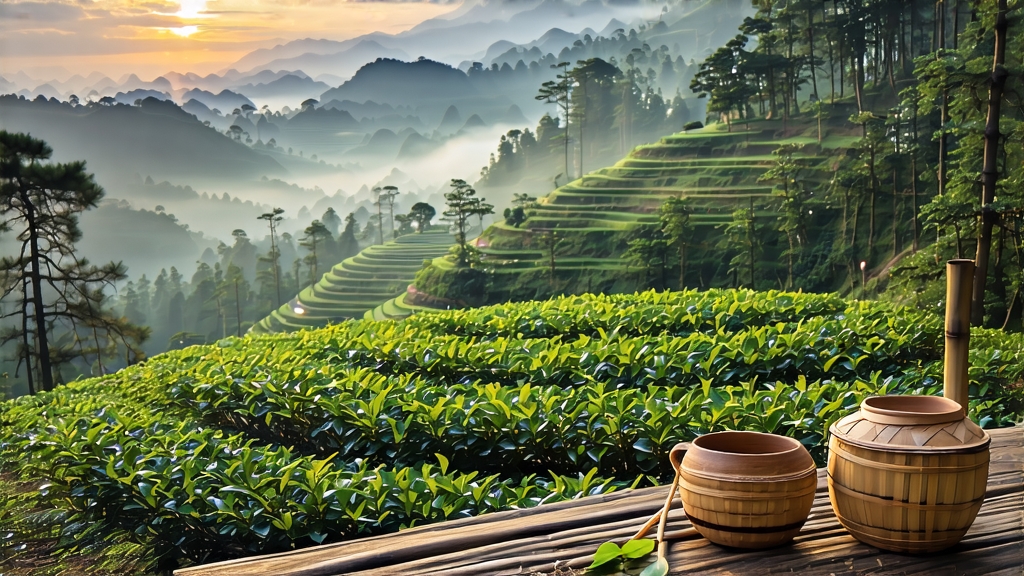
Ask most tea lovers to name the first black tea ever created and they will probably hesitate; mention Lapsang Souchong, however, and eyes light up with recognition of its unforgettable campfire aroma. Hailing from the granite gorges of the Wuyi Mountains in China’s Fujian province, this extraordinary leaf is not merely a beverage—it is a time capsule of Ming-dynasty innovation, Dutch maritime trade, and the very birth of the category Westerners still call “black tea.” To understand Lapsang Souchong is to understand how China taught the world to drink beyond green.
Historical Roots
Local legend places the origin in 1646, when Qing soldiers forced tea farmers to abandon their freshly picked leaves. Returning days later, the farmers found the leaves oxidised dark. To salvage them, they dried the crop quickly over pinewood fires; the result was a sweet, resinous liquor that delighted the first Dutch merchants who carried it to Europe. Whether myth or fact, documents from the Dutch East India Company show “bohea” (the Min-bei pronunciation of Wuyi) reaching Amsterdam by 1604, making Lapsang Souchong the earliest black tea exported from China. By the late 17th century it had become the costliest tea at London auctions, inspiring imitations from India and Ceylon that still define global breakfast blends today.
Terroir and Cultivar
Authentic Lapsang Souchong comes only from Tongmu Guan, a protected enclave above 1,200 m where mist, pine, and bamboo filter 70 % of sunlight. The native cultivar is Xiao Ye Zhong (“small-leaf species”), a slow-growing bush whose thick, waxy leaves accumulate more aromatic oils than lowland varieties. Spring nights can dip to 8 °C, prompting the plant to convert starch into natural sugars that later caramelise during smoking, giving the tea its signature malty sweetness.
Two Styles: Traditional Smoke vs. Modern “Unsmoked”
Purists divide Lapsang Souchong into two camps. The classic, export-grade leaf is withered over burning Masson pine, rolled, oxidised 80–90 %, then finished in bamboo baskets suspended above resin-rich fir logs. A cooler, smouldering fire imparts a glossy tar-black colour and a scent reminiscent of lapsang whisky. Since 2005, however, local makers have also crafted an “unsmoked” version aimed at the domestic market that relies solely on charcoal heat and precise oxidation to reveal cocoa, longan, and honey notes. Both styles share the same cultivar and mountainside minerality, yet offer dramatically different cup profiles.
Crafting the Smoke: A Step-by-Step Look
- Plucking: only the top two leaves and a bud are taken before the Qingming festival when polyphenol levels peak.
- Withering: trays rest above pinewood fires in an attic-like loft; temperature climbs gradually from 28 °C to 38 °C over eight hours while artisans flip the leaves every 30 minutes.
- Rolling: a 45-minute machine knead ruptures cells without breaking veins, releasing catechins that will later polymerise into theaflavins.
- Oxidation: leaves rest 3–4 hours in cedar-lined troughs; humidity is kept at 85 % to encourage coppery colour.
- Smoking & Drying: the critical “song xun” phase sees the tea passed through three successive rooms—each cooler and smokier—until moisture drops below 5 %. Master smokers judge readiness by aroma alone, aiming for a balance where pine complements rather than masks the leaf’s natural fruitiness.
- Sorting: finally, stalks and flakes are winnowed by hand; only jet-black, evenly curled strips earn the Tongmu seal.
Chemical Alchemy
Gas chromatography reveals 32 volatile phenols, the most emblematic being guaiacol and 4-methylguaiacol, compounds also found in roasted coffee and peated malt. Yet contrary to assumption, the smoke does not dominate antioxidant content; Lapsang Souchong still delivers 18–22 % theaflavins, rivalling many unscented black teas. The key is timing: too hot a fire converts lignin into harsh creosote, while gentle smoulder yields sweet syringol, the molecule behind its signature pipe-tobacco note.
Grading Language
Western vendors